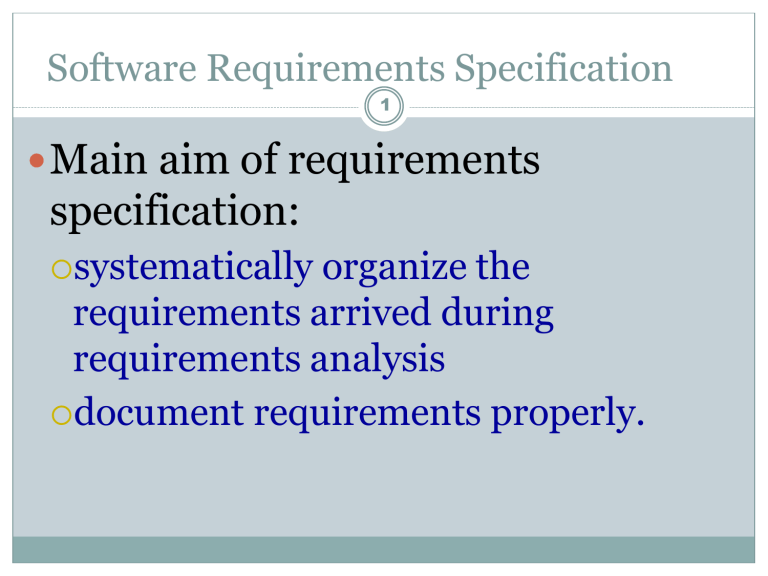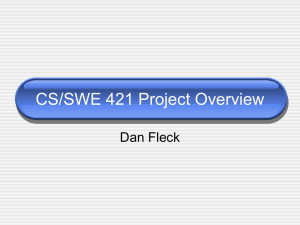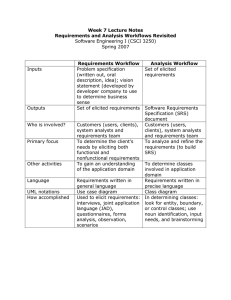
Software Requirements Specification
1
Main aim of requirements
specification:
systematically
organize the
requirements arrived during
requirements analysis
document requirements properly.
Software Requirements Specification
2
The SRS document is useful in
various contexts:
statement
of user needs
contract document
reference document
definition for implementation
Software Requirements Specification: A Contract
Document
3
Requirements document is a reference
document.
SRS document is a contract between the
development team and the customer.
Once the SRS document is approved by the customer,
any subsequent controversies are settled by referring the SRS
document.
Software Requirements Specification: A Contract
Document
4
Once customer agrees to the SRS
document:
development
team starts to develop the product
according to the requirements recorded in the
SRS document.
The final product will be acceptable to the
customer:
as
long as it satisfies all the requirements
recorded in the SRS document.
SRS Document (CONT.)
5
The SRS document is known as black-box
specification:
the
system is considered as a black box whose
internal details are not known.
only its visible external (i.e. input/output)
behavior is documented.
Input Data
S
Output Data
SRS Document (CONT.)
6
SRS document concentrates on:
what
needs to be done
carefully avoids the solution (“how to do”)
aspects.
The SRS document serves as a contract
between
development team and the customer.
Should be carefully written
SRS Document (CONT.)
7
The requirements at this stage:
written
using end-user terminology.
If necessary:
later
a formal requirement
specification may be developed from it.
Properties of a good SRS document
8
It should be concise
and at the same time should not be ambiguous.
It should specify what the system must do
and not say how to do it.
Easy to change.,
i.e. it should be well-structured.
It should be consistent.
It should be complete.
Properties of a good SRS document
(cont...)
9
It should be traceable
you should be able to trace which part of the
specification corresponds to which part of the
design and code, etc and vice versa.
It should be verifiable
SRS Document (CONT.)
10
SRS document, normally
contains three important parts:
functional
requirements,
nonfunctional requirements,
constraints on the system.
SRS Document (CONT.)
11
It is desirable to consider every system:
performing a set of functions {fi}.
Each function fi considered as:
transforming a set of input data to corresponding output
data.
Input Data
fi
Output Data
Example: Functional Requirement
12
F1: Search Book
Input:
an author’s name:
Output:
details of the author’s books and the locations of these books
in the library.
Author Name
f1
Book Details
Functional Requirements
13
Functional requirements describe:
A
set of high-level requirements
Each high-level requirement:
takes
in some data from the user
outputs some data to the user
Each
high-level requirement:
might
consist of a set of identifiable
functions
Functional Requirements
14
For each high-level requirement:
every
function is described in terms
of
input
data set
output data set
processing required to obtain the output
data set from the input data set
Nonfunctional Requirements
15
Characteristics of the system
which can not be expressed as
functions:
maintainability,
portability,
usability,
etc.
Nonfunctional Requirements
16
Nonfunctional requirements include:
reliability issues,
performance issues,
human-computer interface issues,
Interface with other external systems,
security, maintainability, etc.
Constraints
17
Constraints describe things that the system
should or should not do.
For example,
how fast the system can produce results
so
that it does not overload another
system to which it supplies data, etc.
Examples of constraints
18
Hardware to be used,
Operating system
or DBMS to be used
Capabilities of I/O devices
Standards compliance
Data representations
by the interfaced system
Examples of Bad SRS Documents
19
Unstructured Specifications:
Narrative essay --- one of the worst types of specification
document:
Difficult to change,
difficult to be precise,
difficult to be unambiguous,
scope for contradictions, etc.
Organization of the SRS Document
20
1. Introduction to the Document
1.1 Purpose of the Product
1.2 Scope of the Product
1.3 Acronyms, Abbreviations, Definitions
1.4 References
1.5 Outline of the rest of the SRS
2. General Description of Product
2.1 Context of Product
2.2 Product Functions
2.3 User Characteristics
2.4 Constraints
2.5 Assumptions and Dependencies
3. Specific Requirements
3.1 External Interface Requirements
3.1.1 User Interfaces
3.1.2 Hardware Interfaces
3.1.3 Software Interfaces
3.1.4 Communications Interfaces
Organization of the SRS Document(contd)
21
3.2 Functional Requirements
3.2.1 Class 1
3.2.2 Class 2
…
3.3 Performance Requirements
3.4 Design Constraints
3.5 Quality Requirements
3.6 Other Requirements
4. Appendices
22
Thank you


